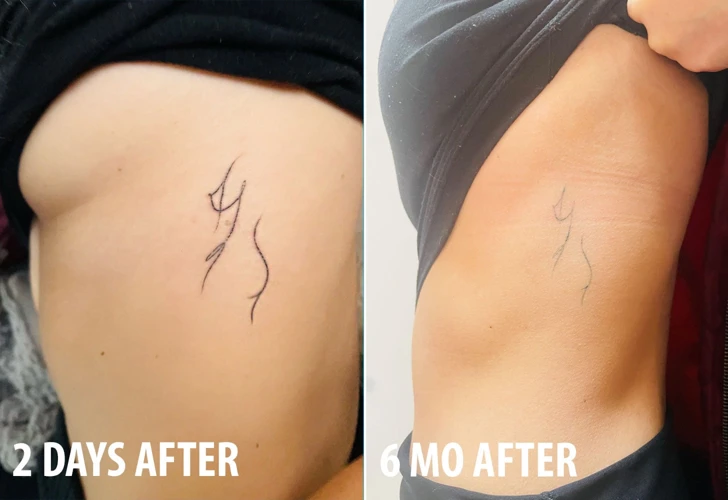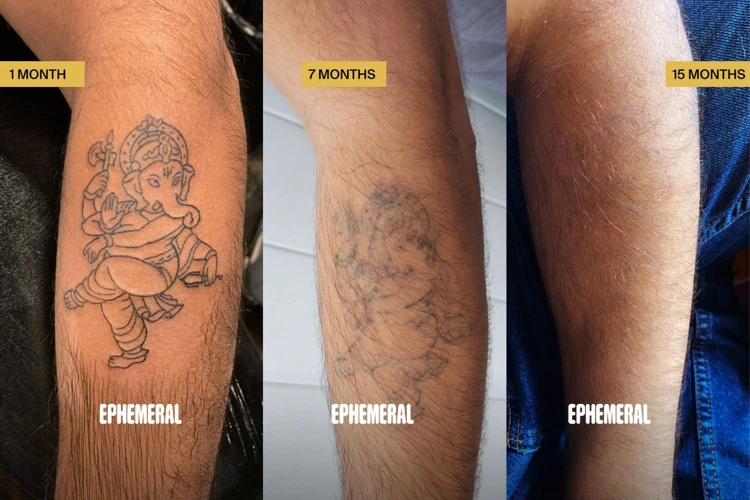If you’ve recently gotten a tattoo and are now wondering why it is fading after only a month, you’re not alone. Many people have experienced the same issue and are left wondering what went wrong. In this article, we’ll explore the common causes of tattoo fading, as well as what you can do to prevent it from happening. We’ll also answer some of the most frequently asked questions about why your tattoo may be fading after a month.
Contents
What Is a Tattoo?

A tattoo is a form of body modification where ink is inserted into the skin with a needle and left to heal. Tattoos can be anything from small and simple to large and complex, and they can feature almost any image, symbol or text. The ink is permanent, so a tattoo is a long-term commitment.
How to Fade a Tattoo While It Is Healing
When a tattoo is still healing, it is possible to fade it by following a few simple steps. First, keep the area clean, and use a mild soap to remove dirt and debris. Next, apply a thin layer of healing ointment to the tattoo, and then wrap it with a non-adhesive bandage. Finally, avoid exposing the tattoo to direct sunlight, and stay out of pools, hot tubs, and other bodies of water. Following these steps can help to minimize the appearance of a tattoo while it is healing.
How Does a Tattoo Fade?

- Sunlight: UV rays from the sun can damage the pigments used in tattoos, causing them to fade.
- Aging: Over time, the body naturally produces less collagen, which can make tattoos appear to fade.
- Incorrect Aftercare: Incorrect aftercare such as exposing the tattoo to the sun, soaking it in water, or not moisturizing it can cause tattoos to fade faster.
- Incorrect Ink: Some inks may not be as permanent as others, and can fade over time.
- Skin Type: Some skin types are more prone to fading than others.
Reasons Why Tattoos Fade After a Month

Sun Exposure
UV rays from the sun can easily damage both the skin and the ink of the tattoo. Sun exposure, even when the skin is protected, can cause the ink to break down and fade faster than it should.
Poor Quality Ink
Using cheap ink or inferior quality ink can lead to fading much sooner than expected. Low-grade and low-cost inks can be more prone to fading and discolouration as they are not as resilient as higher quality inks.
Poor Aftercare
It is important to keep the tattoo clean and moisturised after it is done. Not following the aftercare instructions provided by the tattoo artist can lead to fading and loss of colour.
Low Quality Tissue
Sometimes the tissue of the skin itself can be the cause of the fading. If the skin is of poor quality or has a low collagen density, it can cause the ink to break down faster.
What Can I Do to Help Keep My Tattoo From Fading?

Apply Sunscreen
Sunscreen is essential for protecting your tattoo from fading. UV rays from the sun can cause the colors in your tattoo to fade and blur. It is best to apply sunscreen with an SPF of at least 30 whenever you plan on being out in the sun for an extended period of time.
Use Quality Inks
Using quality inks is key to preventing your tattoo from fading. Cheap inks can contain less pigment and fade faster than quality inks. It is best to ask your artist what type of ink they are using and do your research before getting a tattoo.
Follow Aftercare Instructions
Following the aftercare instructions given to you is crucial to preventing your tattoo from fading. Aftercare instructions usually involve keeping the area clean, moisturized, and protected from the sun. It is important to follow these instructions to ensure that your tattoo stays vibrant.
Choose a Quality Tattoo Parlor
Choosing a quality tattoo parlor is important for keeping your tattoo from fading. Look for a parlor that uses quality inks and has experienced artists. Do your research and read online reviews to find a reputable parlor.
Can I Fade a Tattoo While It Is Healing?

Natural Methods
There are several natural methods for fading tattoos, but they are not recommended. Exposing the tattoo to direct sunlight can cause it to fade faster, however, it can also lead to sunburn and skin damage. Applying lemon juice and salt to the tattoo can also cause it to fade, but this can cause irritation and allergic reactions.
Chemical Methods
Chemical methods can be used to fade tattoos, but they should be used with caution. Laser treatments are the most common method of tattoo fading, but they can be expensive and painful. Chemical peels and skin lightening creams can also be used to fade tattoos, but these can cause skin irritation and allergic reactions. It is important to consult a doctor or dermatologist before using any chemical methods to fade a tattoo.
Pros and Cons of Fading a Tattoo While It Is Healing
- Pros: Fading a tattoo while it is healing can help reduce the risk of infection, as it allows your skin to heal faster and more efficiently. It can also help make the tattoo look more vibrant and reduce the risk of fading.
- Cons: Fading a tattoo while it is healing can cause the tattoo to fade or blur more quickly. It can also increase the chances of the tattoo becoming infected or irritated.
The best way to avoid any of these issues is to wait until the tattoo is completely healed before fading it. This will help to ensure that your tattoo looks its best and lasts for years to come.
Frequently Asked Questions
What Can I Do to Prevent My Tattoo from Fading?
To prevent your tattoo from fading, it is important to take good care of it. This includes washing it regularly with a mild, unscented soap and applying a layer of fragrance-free lotion after it has dried. Avoiding exposure to the sun, chlorine, and other harsh chemicals is also essential. Additionally, refrain from picking or scratching at the tattoo and protect it with clothing or sunscreen when outdoors. Lastly, getting a touch-up or a cover-up may be necessary if the original design fades.
Are there any specific aftercare instructions I should follow?
- Keep the tattoo covered and clean – Apply a thin layer of ointment or petroleum jelly to the tattoo, and cover with a bandage for the first few days. After that, use a mild, unscented soap and warm water to gently clean the area. Pat dry with a clean, soft towel.
- Moisturize regularly – Apply a quality lotion or moisturizer multiple times a day for the first week. After that, switch to a moisturizer with SPF to help protect the tattoo from the sun’s UV rays.
- Avoid sun exposure – Sun exposure can fade tattoos quickly, so use sunscreen and cover up with clothing when outdoors.
- Stay away from swimming pools, hot tubs, and other bodies of water – Chlorine and other chemicals in the water can damage the tattoo.
- Don’t pick or scratch the area – This can lead to infection and can cause the tattoo to fade.
Are There Any Specific Types of Tattoos That Are More Prone to Fading?
Simple tattoos, such as line work and dot work, are more prone to fading than those with more intricate designs. The amount of detail in a design will affect the longevity of the tattoo, as more complex designs will generally require more ink and more layers of shading. Coloured tattoos can also be more prone to fading, as the pigments used are more likely to cause discoloration over time. Lighter colours are particularly susceptible to fading, while dark colours are more likely to be preserved. Additionally, areas of the body exposed to more sunlight, such as the hands, feet, and face, are more likely to have their tattoos fade faster.
How Can I Tell If My Tattoo Is Starting To Fade?
- Color Fading: One of the easiest ways to tell if a tattoo is starting to fade is to look for changes in the colors. A faded tattoo will appear less vibrant and may appear duller than when it was first applied.
- Loss of Contrast: Another way to tell if a tattoo is fading is to look for areas where the lines and colors are beginning to blur together. This can occur when the ink loses its contrast and becomes less distinct.
- Loss of Crispness: As a tattoo fades, it can start to look less sharp and crisp. Colors may appear to blend together and edges may become less distinct.
- Changes in Texture: A tattoo that is fading may also appear less smooth or raised compared to when it was first applied. The skin may also feel dry or scaly to the touch.
Is there a way to restore the color of a fading tattoo?
Yes, there are several ways to restore the color of a fading tattoo. These include:
- Tattoo touch-up: A touch-up is a procedure in which a tattoo artist re-inks the tattoo to restore the color. This is the most common way to restore the color of a fading tattoo.
- Tattoo maintenance: This involves regularly exfoliating and moisturizing the tattoo to keep the ink from fading. It can also help to protect the tattoo from sun damage.
- Tattoo laser removal: This is a procedure in which a laser is used to break up the ink particles so that they can be re-applied to the skin. This is a more expensive option and should be used with caution.
It is important to note that no matter what method is used, the results may not be permanent and the tattoo may continue to fade over time.
Conclusion
Tattoos can fade after a month for various reasons, such as poor aftercare, exposure to sunlight, and the quality of the tattoo. To avoid fading, it is important to take proper care of a tattoo, such as avoiding direct sunlight, applying a moisturizer, and avoiding picking at the skin. Additionally, it is important to choose a reputable tattoo artist and quality ink to ensure the tattoo lasts as long as possible.